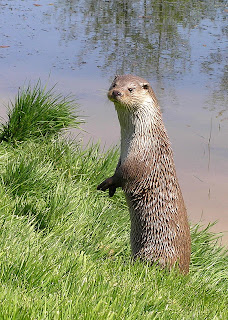
Some more photos from last weeks trip to the British Wildlife Centre. In the afternoon we went into the Wild cat enclosures.
Wild Cat - Felis silvestris
Britain's only wild member of the cat family bears a close resemblance to the domestic tabby, but it is more striped and has a bushier, blunt-ended tail marked with thick black rings. Now confined to the Scottish highlands, wild cats disappeared from southern England in the 16th century; the last one recorded in northern England was shot in 1849.
The Wildlife and Countryside Act gives strict legal protection to wild cats and their dens. They are easily confused with 'feral' cats, which are domestic cats living wild, of which there are about 900,000 in Britain today.
Unfortunately the two species also interbreed to give hybrids, which makes it extremely difficult to define the genetic purity of a wildcat.
The wild cat has suffered considerable decline in population and is now considered at serious risk of extinction in this country.
The cats may look like the domesticated cat, but no way would you pick one of these up and stroke it. They hissed if they felt you were too close and we were warned to always allow them an escape route
 Its been rather dreary this week and I have not taken many photos. The fungus on the tree is in a local carpark. It is know as Chicken in the woods and when young is edible,
Its been rather dreary this week and I have not taken many photos. The fungus on the tree is in a local carpark. It is know as Chicken in the woods and when young is edible, This is the bridge at Kingshat where we walked on Tuesday. We had to wade to the bridge because heavy rain had caused the River Beaulieu to burst its banks. Unfortunately on our return crossing we had a rather nasty experience when a rather large Staffordshire bull terrier attacked Missy. Apart from a few scratches she was Ok but in recusin Missy , Karen got a small bite.as the dog continued to try and get at Missy. Missy was very shaken by the experience and when the owner of the dog realised that karen had been bitten she quickly fled the scene. Other than admitting that her dog was responsible for the attack and was going to be in "Big trouble she did very little to try and control her dog eventually aiming a few kicks at it. We did report it to the dog warden as had a smaller dog or a child been involved the outcome could have been much more serious.
This is the bridge at Kingshat where we walked on Tuesday. We had to wade to the bridge because heavy rain had caused the River Beaulieu to burst its banks. Unfortunately on our return crossing we had a rather nasty experience when a rather large Staffordshire bull terrier attacked Missy. Apart from a few scratches she was Ok but in recusin Missy , Karen got a small bite.as the dog continued to try and get at Missy. Missy was very shaken by the experience and when the owner of the dog realised that karen had been bitten she quickly fled the scene. Other than admitting that her dog was responsible for the attack and was going to be in "Big trouble she did very little to try and control her dog eventually aiming a few kicks at it. We did report it to the dog warden as had a smaller dog or a child been involved the outcome could have been much more serious. Missy was very clingy for the rest of the day and snuggled up to Raffles for comfort.
Missy was very clingy for the rest of the day and snuggled up to Raffles for comfort. Meanwhile on the ponds we saw the goslings, who have all grown although there are only 9 now. The second swan family has disappeared and we are hoping that it may have been relocated in an area without a resident family.
Meanwhile on the ponds we saw the goslings, who have all grown although there are only 9 now. The second swan family has disappeared and we are hoping that it may have been relocated in an area without a resident family. Missy was back to her happy self when we walked at Pigbush, also flooded from the recent rain.
Missy was back to her happy self when we walked at Pigbush, also flooded from the recent rain.















































